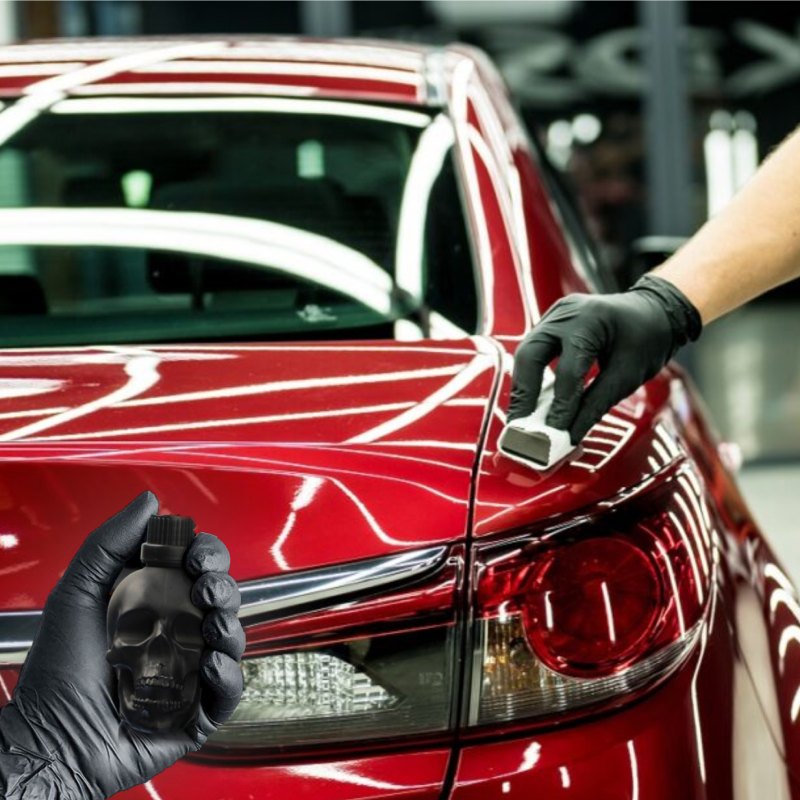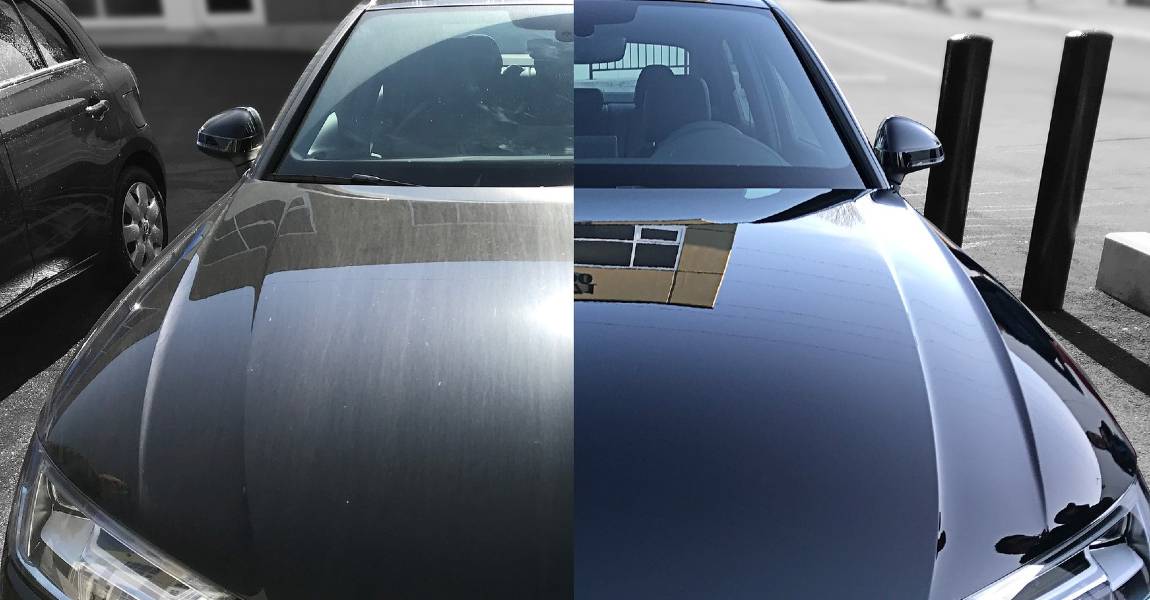Why families prefer Ceramic Coating Newark for low maintenance
Wiki Article
Discovering the Scientific Research Behind Car Ceramic Coating and Its Protective Features
The science of car ceramic coating presents a remarkable study in sophisticated automobile security. Composed mostly of silicon dioxide and polymers, these layers create a durable bond with lorry paint. This communication improves sturdiness against environmental threats while offering hydrophobic benefits. However, the intricacies of how these layers job and their long-term benefits remain much less understood. Unboxing these information reveals why ceramic layers are coming to be a recommended option for vehicle treatmentWhat Is Ceramic Coating?
Ceramic coating is a fluid polymer that chemically bonds to the surface of a vehicle's paint. This advanced protective layer enhances resilience and provides superior resistance to ecological aspects. Unlike standard wax or sealants, which provide temporary defense, ceramic layers produce a long-lasting guard that can hold up against rough conditions such as UV rays, acidic contaminants, and extreme weather. When applied properly, the coating develops a hydrophobic surface, causing water to grain and slide off, which assists in preserving the vehicle's sanitation. In addition, it uses improved gloss and depth to the paint, making the lorry appear more polished and vivid. The application procedure generally includes extensive surface prep work, consisting of cleaning and polishing, to guarantee peak bonding. Therefore, ceramic coatings are ending up being significantly prominent among car lovers and those seeking to secure their financial investments, guaranteeing to keep the lorry's visual allure while minimizing the regularity of maintenance.The Structure of Ceramic Coatings
The complex formula of ceramic finishes largely is composed of silicon dioxide (SiO2), which is originated from all-natural sources like quartz and sand. This essential component offers the structure for the coating's sturdiness and safety high qualities. Along with SiO2, ceramic finishes typically consist of various polymers and ingredients that enhance bond, flexibility, and resistance to ecological aspects. These compounds work synergistically to create a robust obstacle against pollutants such as dust, chemicals, and UV rays.Furthermore, some formulations include titanium dioxide (TiO2) or various other nanomaterials, which can enhance the coating's hydrophobic buildings, resulting in improved water repellency. The exact composition can vary greatly amongst suppliers, affecting performance and longevity. Ultimately, the combination of these elements culminates in a protective layer that not only enhances the aesthetic appeal of cars however likewise offers to lengthen their life-span by shielding the surface from prospective damages.Just How Ceramic Coatings Work
Comprehending exactly how ceramic coatings function involves discovering their chemical make-up, which adds to their safety top qualities. The application process is crucial for attaining ideal outcomes, while durability and toughness aspects determine the coating's efficiency gradually. With each other, these aspects highlight the benefits and performance of ceramic coverings for car defense.Chemical Structure Explained
While numerous car owners look for durable security for their cars, the chemical make-up of ceramic finishes plays a vital duty in their effectiveness. These finishings largely include silicon dioxide (SiO2), which is originated from natural minerals. This compound develops a solid bond with the vehicle's paint, producing a long lasting, protective layer. Furthermore, several ceramic coverings consist of titanium dioxide (TiO2), improving their hydrophobic buildings and resistance to UV rays. The existence of polysiloxanes can additionally improve versatility and sturdiness. Together, these aspects add to the coating's capacity to fend off water, dust, and contaminants, while likewise giving a high-gloss surface. Recognizing this chemical foundation helps car owners value the durable protection used by ceramic finishings.Application Process Summary
Using ceramic layers entails a thorough procedure that ensures perfect bonding and protection for the vehicle's surface. At first, complete cleansing and decontamination of the car's outside are executed to remove dirt, crud, and previous waxes. This step verifies that the surface is free from impurities that can prevent bond. Following this, the paint is commonly polished to boost clarity and remove any flaws. When prepared, the ceramic coating is applied in tiny sections making use of an applicator pad, permitting uniform insurance coverage. The coating is then delegated treat, developing a strong chemical bond with the surface. Proper curing times and conditions are essential, as they verify the coating accomplishes its maximum efficiency and safety top qualities.Longevity and Longevity Elements
Ceramic finishings are developed to provide durable defense with their sophisticated chemical structure, which creates a robust obstacle against ecological contaminants. The longevity of these finishes is influenced by variables such as the thickness of the application, the top quality of the product, and the problems under which the car is revealed. High-quality ceramic finishes can last several years, resisting scrapes, UV rays, and chemical discolorations. Appropriate upkeep, consisting of regular washing and regular reapplication, can additionally improve durability. Furthermore, ecological variables like environment and direct exposure to toxins can impact the life-span of the coating. In general, when used and preserved appropriately, ceramic finishes provide remarkable longevity, making them a prominent selection for car enthusiasts looking for to maintain their car's look.Hydrophobic Residences and Water Repellency
Hydrophobic buildings are a characteristic of top quality car ceramic coatings, considerably enhancing the vehicle's surface area performance. These finishes develop a molecular bond with the car's paint, leading to a surface area that look at here repels water successfully. When water enters into call with a ceramic-coated surface, it grains up and rolls off, minimizing the quantity of fluid that remains on the paint. This actions not only contributes to an aesthetically pleasing look yet likewise minimizes the buildup of pollutants such as dirt, grime, and road salts.The boosted water repellency results in less complicated cleaning and upkeep, as much less effort is called for to eliminate undesirable compounds. Furthermore, the hydrophobic nature of ceramic coatings assists in protecting against water areas, which can mar the finish of uncoated surfaces. On the whole, the incorporation of hydrophobic residential properties in ceramic layers plays an essential duty in keeping the lorry's excellent look while simplifying try here maintenance.Security Against Scratches and UV Damages
Car ceramic finishings offer substantial protection versus scratches and UV damage. The scrape resistance mechanism develops a long lasting layer that takes in impacts, while the UV shielding advantages assist preserve the automobile's paint stability gradually. With each other, these functions add to a longer-lasting and visually attractive surface.Scrape Resistance Device
Making use of innovative modern technology, ceramic coatings give a durable guard against scrapes and UV damage, boosting the durability and appearance of lorry surfaces. The scrape resistance system of these coatings is connected to their special molecular structure, which forms a long lasting bond with the vehicle's paint. This bond develops a hard, protective layer that can soak up effects and stand up to abrasions. Furthermore, the smooth surface area of the coating minimizes friction, making it tough for pollutants to stick and trigger scrapes. The chemical composition of ceramic coatings usually consists of nanoparticles that enhance the protective layer, further enhancing its durability. Lorries treated with ceramic finishings show considerably enhanced scrape resistance contrasted to traditional wax or sealers, ensuring a pristine coating over time.UV Protecting Perks
The protective qualities of ceramic finishings prolong past scratch resistance to consist of substantial UV securing advantages. These finishes develop a durable barrier that reflects damaging ultraviolet rays, guarding the lorry's paint and underlying products. Extended exposure to UV radiation can lead to fading, oxidation, and wear and tear of the paint finish. By incorporating ceramic layers, car proprietors can efficiently minimize these dangers, maintaining the aesthetic allure and stability of their autos. Furthermore, the UV blocking properties add to boosted long life, minimizing the regularity of painting and upkeep. Eventually, the combination of ceramic finishes provides a complete remedy for shielding lorries from the destructive results of sunlight exposure, guaranteeing a continual, dynamic look in time.The Long life and Maintenance of Ceramic Coatings

Regularly Asked Inquiries
Can Ceramic Coating Be Applied to Any Kind Of Kind Of Lorry?
Ceramic coating can be put on different kinds of lorries, consisting of cars, vehicles, and bikes. Nevertheless, surface prep work and compatibility with details products are important for optimal attachment and efficiency of the coating.Exactly How Much Does Ceramic Coating Commonly Cost?
Ceramic coating usually costs in between $500 and $2,000, relying on variables such as lorry dimension, coating quality, and expert application. The investment can offer lasting security and enhance the lorry's look over time.
Is Specialist Application Needed for Finest Results?
The necessity of professional application often relies on wanted outcomes. Professionals generally guarantee correct surface area prep work and application strategies, causing excellent bonding and long life of the coating, which might be testing for unskilled people to accomplish.Can Porcelain Coatings Be Removed or Fixed?
Ceramic layers can be gotten rid of or repaired, though the process may need details solvents or strategies - Ceramic Coating Newark. Correct elimination is necessary to avoid damages to the underlying surface area, highlighting the relevance of professional assistance for ideal outcomesHow Does Porcelain Coating Contrast to Standard Wax?
The contrast in between ceramic coating and traditional wax reveals that ceramic coverings supply remarkable longevity, improved protection versus ecological pollutants, and longer-lasting shine, while wax calls for much more constant application and supplies much less general resistance to damages.Report this wiki page